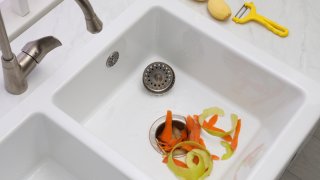
A local plumbing company in Baltimore, Maryland, is causing a stir online regarding a kitchen appliance that might be a bit of a misnomer.
On Oct. 18, Prime Plumbing posted a TikTok in which several of its plumbing professionals are asked a simple question: “What is one thing you should never put down your garbage disposal?” Their answers have led to a rousing and sometimes contentious discussion in the comments section.
The first Prime Plumbing employee thinks deeply for a moment before replying, “Anything.”
Get Boston local news, weather forecasts, lifestyle and entertainment stories to your inbox. Sign up for NBC Boston’s newsletters.
Other plumbing experts answer with familiar items like “chicken bones,” “eggshells” and “rice.” Another man says, “Everything,”
“Anything starchy,” another person adds, meaning foods like rice, potatoes, pasta, cereal and bread.
“Food,” says the final expert.
U.S. & World
The plumbers’ answers seemed to shock viewers, with thousands taking to the comments to share their (mostly humorous) thoughts.
“Everything they mentioned I put in my garage disposal today 😆😂,” one TikToker commented.
“Cucumber peels, old cooked nooodles, have learned the hard way,” wrote another commenter.
“My apt neighbor cleaned out her fridge and all of her food clogged our shared pipes and it started backing up into my kitchen and bathroom,” shared another commenter, painting a vividly icky image.
Some folks took the opportunity to share the wildest things they have witnessed disappear into the growling monster living in their sinks.
“Well mines going strong 22 years and I put a lot of egg shells in there lol,” wrote another commenter, perhaps mind-melding with another commenter who said, “I’ve put at least 900,000 egg shells in the garbage disposal.”
“I watched my grandma throw a whole jersey mikes (sandwich) down the garbage disposal last week,” commented another, to which someone else replied, “What did the sub do to gramma 😂.”
So, what’s the point of a garbage disposal?
“With garbage disposals, the best way to think of them is that they’re really designed for the stuff that comes off when you’re actually cleaning your dishes,” Adam Hauf, Prime Plumbing’s operations manager, tells TODAY.com. “Best practice is always to go ahead and dispose of the big chunks, scrape your plate off right into the trash can.”
Hauf says that a disposal is meant for the little bits of food that remain on your dishes after that initial scrape, adding that it doesn’t matter how much you try to scrape a dirty plate clean, there’s always going to be a little residue.
“It’s really designed for the residual that is bound to wind up in your kitchen sink to grind it up smaller so that it’s less likely to cause a backup or negatively impact your draining system,” he explains.
Hauf notes that it’s less about the garbage disposal itself and more about, well, the plumbing.
“You know, if you get a really high horsepower model, they’ll grind bones, oyster shells, they can grind almost anything,” Hauf says. “The problem is less about the wear and tear on a disposal and more about the impact of the items on your draining system.”
Regarding the starches, including rice, which several plumbers mentioned are a disposal no-no, it all comes down to clumping.
“If you ever cook a pot of pasta or rice, it sticks together. So when you grind it up, some will go down the drain, but those starches can stick to the side of your line,” he says. “What will happen is you get build up, little by little. And then next thing you know, your kitchen sink is overflowing.”
Marla Mock, president of Molly Maid, told TODAY.com in our comprehensive garbage disposal cleaning guide that home cooks should steer clear of tossing a range of things into their garbage disposal, including fat, grease, oil, seafood shells, meat, bones, fruit pits and starchy foods like pasta, potatoes and oats.
“One of the simplest things you can do to help mitigate risk of a backup is to make sure that before you run the disposal, you start running some cold water and then after the disposal is off, let that cold water run for you know, another 45 seconds to a minute,” Hauf adds. “That way any food debris has a chance to catch some water and flow out of the trap and then down further into your drainage system.”
This story first appeared on TODAY.com. More from TODAY:



